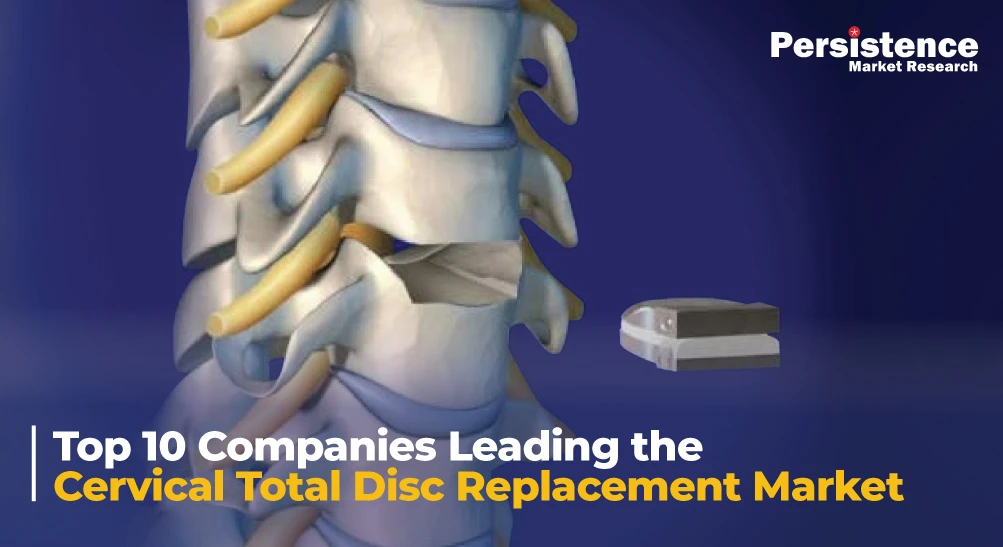- Blog
- Cervical Total Disc Replacement Market
Top 10 Companies Leading the Cervical Total Disc Replacement Market
Published On : 6 Oct 2025
The cervical total disc replacement market represents a significant advancement in the treatment of cervical spine disorders, particularly for patients suffering from degenerative disc disease. Unlike traditional spinal fusion surgeries, cervical total disc replacement devices aim to preserve natural neck movement while relieving pain and restoring function. These implants replicate the flexible properties of a healthy spinal disc, enabling bending, twisting, and rotation without the loss of motion.

As the prevalence of cervical spine issues increases due to aging populations and lifestyle factors, there is a growing demand for surgical options that offer faster recovery times and better long-term outcomes. Technological innovation in implant materials, design, and surgical methods continues to drive market growth, with key manufacturers introducing devices that improve durability, biocompatibility, and ease of implantation. Strong adoption of minimally invasive techniques and expanding surgeon expertise further support the increasing use of cervical total disc replacement procedures globally. Companies operating in the cervical total disc replacement space focus on several strategies to broaden their reach. These include partnerships with distributors in emerging markets, collaborations with academic centers to support surgeon training, and acquisitions aimed at expanding product portfolios.
The following profiles highlight the leading manufacturers whose products are shaping the future of cervical disc replacement therapy through ongoing research, regulatory approvals, and clinical adoption.
1. DePuy Synthes (Johnson & Johnson)
DePuy Synthes leads with the Prodisc C family of cervical disc replacements. The Prodisc C is a three-piece modular implant comprising two cobalt-chromium-molybdenum alloy endplates coated with titanium to encourage bone growth and a polyethylene insert that acts as a cushion, allowing sliding and rotation. Its design is based on a ball-and-socket concept permitting a natural range of motions including bending forward and backward, side bending, and rotation. The implant sizes vary widely, with different footprints and heights to better fit different patients’ vertebrae. The central keel design on the endplates provides strong primary fixation, which minimizes the risk of migration post-surgery. Clinical studies have shown patients retain near-normal neck motion for years after implantation, and the device aims to reduce the need for additional surgeries on adjacent spinal segments, a common complication in fusion surgeries.
2. Medtronic
Medtronic’s cervical discs include the Prestige and Bryan models. The Prestige is known for its metal-on-metal articulating surfaces, providing durability and smooth motion with high wear resistance. The Bryan cervical disc incorporates titanium shells with a lubricated polymer core, allowing natural neck movement with reduced friction. Both products offer reliable segmental motion preservation and promote bone growth for long-term stability. These devices support minimally invasive surgical approaches and are approved in many global markets.
3. NuVasive
NuVasive offers Simplify and PCM cervical discs, which emphasize ease of implantation and secure fixation. Their products use proven biomaterials combined with precise anatomical shapes to provide stable and durable motion-preserving implants. NuVasive invests heavily in surgeon training programs to improve adoption of these implants and continues to enhance its portfolio through research and acquisitions.
4. Globus Medical
Globus Medical’s Secure-C disc consists of metal endplates and a plastic core designed to mimic natural neck motion, allowing flexion, extension, lateral bending, and axial rotation. The implant’s curved surfaces enhance stability by evenly distributing loads. Its three-piece design offers a balance of movement and support that is tailored to maintain alignment and reduce stress on adjacent discs.
5. LDR Holdings
LDR Holdings produces the Mobi-C cervical disc with a mobile core that enables multidirectional movement, closely replicating the biomechanics of a natural cervical disc. The device incorporates design features that limit excessive motion for safety while allowing flexibility needed for functional movement.
6. Centinel Spine
Centinel Spine markets iterations of the Prodisc C including Prodisc C Vivo and Prodisc C Nova. These versions continue to improve on the original design by optimizing footprint sizes and implant heights. They feature cobalt-chrome alloy plates with titanium plasma spray coatings that encourage bone integration and polyethylene cores that facilitate smooth motion.
7. Aesculap Implant Systems (B. Braun)
Aesculap offers cervical disc prosthetics with a focus on strong fixation and natural motion. Their products use durable metals and plastics engineered for biocompatibility and long-term performance. The implants are designed to minimize surgical complications and facilitate patient recovery.
8. Stryker Corporation
Stryker’s cervical disc devices combine patient-centered design with surgical ease. They emphasize robustness and longevity in the implant materials and provide surgical tools optimized for accurate placement, aiming to improve clinical outcomes and procedural efficiency.
9. Zimmer Biomet
Zimmer Biomet develops cervical discs that focus on stability and bone integration. Their devices employ advanced biomaterials that encourage bone ongrowth to ensure the implant stays fixed within the vertebrae. The implants also allow physiological motion and are tailored for long-term spinal health.
10. NuVasive Specialized Spine
NuVasive’s specialized spine division targets complex cervical conditions by providing custom disc replacement options. Their specialized implants integrate advanced biomaterials and designs to address challenging anatomical variations and improve outcomes in difficult cases.
These companies represent a broad spectrum of the cervical total disc replacement market with products that vary in design philosophy but share the common goal of restoring neck mobility and reducing pain. Their devices combine materials science, biomechanical engineering, and surgical considerations to meet different patient needs and regulatory requirements worldwide. This diverse field continues to grow, supported by new product launches and clinical data supporting improved patient results.
Industry Report

Request Report Sample
Your privacy is important to us; your data is secure
Contact Us
Latest Reports
-
Underbody Anti-Rust Coating Market by Product Type (Water-based Coatings, Solvent-based Coatings, Powder Coatings, Elastomeric Coatings), Application (Brush Application, Spray Application, Roller Application, Dip Application), End-User (Automotive, Aerospace, Marine, Construction, Industrial Machinery), and Regional Analysis for 2026-2033
-
Solar Power Mobile Devices Market by Device Type (Smartphones, Tablets, Laptops, Wearable Devices, Portable Chargers), Solar Technology (Monocrystalline Solar Cells, Polycrystalline Solar Cells, Thin-Film Solar Cells), Application (Consumer Electronics, Outdoor & Camping Gear, Emergency Power Supply, Industrial Applications, Commercial Use), and Regional Analysis for 2026-2033
-
Non-Dairy Milk Market by Product Type (Almond Milk, Soy Milk, Coconut Milk, Oat Milk, Rice Milk, Cashew Milk, Hemp Milk, Pea Milk, Others), Application (Beverages, Food, Nutraceuticals, Others), Distribution Channel (Supermarkets/Hypermarkets, Online Retail, Convenience Stores, Others), and Regional Analysis for 2026-2033
-
Multiwall Carbon Nanotube Market by Product Type (Standard MWCNTs, Functionalized MWCNTs, Decorated MWCNTs, Composite MWCNTs), Application (Electronics, Energy, Biomedical, Aerospace & Defense), End-User (Electronics & Electrical, Automotive, Healthcare, Construction, Aerospace & Defense), and Regional Analysis for 2026-2033
-
Micro-Speaker Market by Product Type (Dynamic Micro-Speakers, Balanced Armature Micro-Speakers, MEMS Micro-Speakers, Piezoelectric Micro-Speakers, Hybrid Micro-Speakers), Application (Smartphones, Wearables, Laptops & Tablets, Automotive Electronics, Medical Devices), End-User (Consumer Electronics, Automotive, Healthcare, Industrial, Telecommunication), and Regional Analysis for 2026-2033
